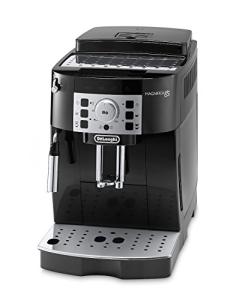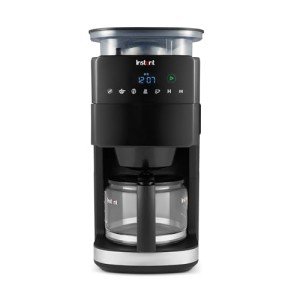
Automatic Espresso Machine
Add a review FollowOverview
-
Founded Date March 15, 1994
-
Sectors ICT
-
Posted Jobs 0
-
Viewed 2
Company Description
Nine Things That Your Parent Teach You About Espresso Bean Grinder
The Ultimate Guide to Espresso Bean Grinders
Coffee fans know that the mission for the perfect Espresso Machine With Customizable Settings begins long before that rich, dark liquid touches the cup. It begins with the beans and, more importantly, how they are ground. An espresso bean grinder plays an essential role in unlocking the flavors and aromas concealed inside each coffee bean. In this thorough guide, we will check out the kinds of espresso mills, their functions, how to pick the right one, and address typical concerns to ensure you enjoy a perfect shot whenever.

The Importance of Grinding Espresso Beans
Espresso extraction is a delicate procedure that needs precision. The grind size straight influences the taste and quality of the espresso shot. Great ground beans increase area, enabling faster extraction, while coarse grinds can result in under-extraction. This is why purchasing a top quality espresso bean grinder is vital.
Table 1: Effects of Grind Size on Espresso
| Grind Size | Texture | Extraction Time | Flavor Profile |
|---|---|---|---|
| Coarse | Gritty | 25-30 seconds | Sour, under-extracted |
| Medium-Fine | Sand-like | 20-25 seconds | Well balanced |
| Great | Powdery | 18-20 seconds | Rich, full-bodied |
| Additional Fine | Finer than powder | 15-18 seconds | Bitter, over-extracted |
Types of Espresso Grinders
When it comes to Espresso Machine With Dual Shot mills, 2 primary types dominate the market: blade mills and burr mills. Comprehending the difference in between these 2 types can assist consumers make a notified choice.
1. Blade Grinders
Blade mills are usually the least pricey choice and are much easier to utilize. They utilize a blade that spins rapidly to slice the beans. Nevertheless, they produce irregular grinds due to the irregular size of the resulting coffee particles. This disparity can considerably affect the quality of the espresso.
Pros:
- Affordable and simple to discover
- Compact and portable
- Quick grinding procedure
Cons:
- Inconsistent grind size
- Can produce heat, affecting taste
- Less ideal for espresso
2. Burr Grinders
Burr mills are frequently advised by coffee connoisseurs. They can be found in 2 ranges: flat burrs and cone-shaped burrs. Both types offer a constant grind size, necessary for espresso.
Pros:
- Even grind size, boosting flavor extraction
- Available in manual and electrical variations
- Adjustable settings for different grind sizes
Cons:
- More costly than blade grinders
- Bigger footprint in the kitchen area
Table 2: Comparison of Blade vs. Burr Grinders
| Feature | Blade Grinder | Burr Grinder |
|---|---|---|
| Consistency | Inconsistent | Highly consistent |
| Grind Size Adjustability | No | Yes |
| Heat Generation | Moderate to high | Minimal |
| Rate Range | Low | Moderate to high |
| Suitable for | Fundamental developing | Espresso and advanced brewing |
Functions to Consider When Choosing an Espresso Grinder
When choosing an espresso bean grinder, it’s vital to consider numerous factors that determine its efficiency, convenience, and longevity.
1. Grind Settings
A grinder with several grind settings enables for flexibility throughout various coffee designs. A perfect Espresso Machine With Dual Shot grinder must have at least 15 various grind size choices.
2. Build Quality
Material quality influences the grinder’s sturdiness and efficiency. Stainless steel burrs are an excellent option as they are robust and do not rust.
3. Grinding Speed
Greater RPM (revolutions per minute) makes the grinding procedure quicker but can produce more heat. Go for mills that stabilize speed and heat generation.
4. Hopper Capacity
Think about just how much coffee you usually brew. A bigger hopper can hold more beans, minimizing the frequency of refills. Nevertheless, a smaller hopper is more compact and can fit into tighter areas.
5. Cost
Quality espresso grinders can range from around ₤ 50 for entry-level blade alternatives to over ₤ 1,000 for high-end burr grinders. It’s necessary to guarantee that the grinder matches your brewing needs and budget.
Regularly Asked Questions (FAQ)
What grind size should I use for espresso?
For espresso, a great grind is generally recommended. The normal range is around 20 microns, however modifications can depend upon the coffee range and your particular espresso machine.
How typically should I grind my espresso beans?
For the very best flavor, it is recommended to grind beans right before developing. Freshly ground coffee offers exceptional fragrance and taste compared to pre-ground options.
Can I utilize a blade grinder for espresso?
While it is possible to use a blade grinder, it is not advised for Commercial Espresso Machine due to the absence of constant grind size, which can result in undesirable taste outcomes.
What is the distinction in between conical and flat burr grinders?
Both types deliver a constant grind size; nevertheless, cone-shaped burrs tend to produce less heat and keep fewer grounds. Flat burrs can grind quicker but might develop heat, affecting taste. Conical burrs are normally preferred for espresso.
Is it worth buying a high-end grinder?
Definitely. A premium grinder can significantly boost the espresso experience by providing consistency and better extraction, causing a richer and more tasty shot.
An espresso bean grinder is more than just a cooking area tool; it is a vital component in the art of coffee preparation. Comprehending the types of mills, their functions, and significance can help anyone from casual drinkers to baristas raise their espresso video game. Whether investing in a manual burr grinder or a high-end electrical model, prioritizing grind quality will unquestionably supply a much better espresso experience. Take pleasure in every sip– after all, it all starts with the grind!

